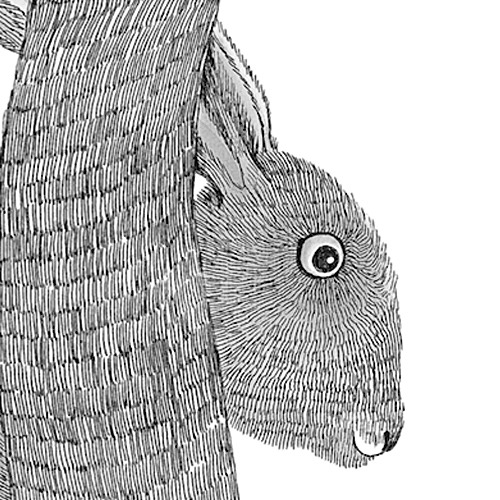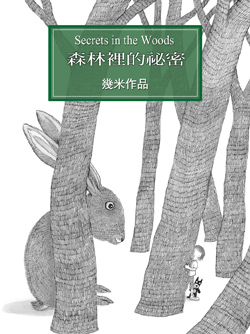< Back to posts
Jimmy Liao | Part 1
Taiwan

Jimmy Liao studied art at Chinese Culture University, and then he worked at an advertising agency and as an editorial illustrator for many years. After surviving a battle with leukaemia in the 90s, Jimmy totally devoted himself to his art, and has since created about forty picturebooks which have sold millions of copies around the world.
In his first of two posts for the Picturebook Makers blog, Jimmy talks about the creation of his debut picturebook, ‘Secrets in the Woods’. This breakthrough work was originally published in Taiwan by Locus Publishing, and is dedicated to Jimmy's daughter.
SUMMONED FROM A MYSTERIOUS REGION
Jimmy: I began creative writing when I was forty years old. ‘Secrets in the Woods’ was my first book. When I started, I was not even sure what creative writing was all about.
I have always had huge respect for creative writing, but I never thought I could do a book myself. Even though people had suggested the idea to me, I always hesitated in fear, as I felt that I had no ability to do it. However, deep down, I was really envious of those successfully published works and writers – especially picturebook writers and their picturebooks.
A serious illness changed my way of thinking about many things. In the early summer of 1997, a publisher asked me to submit a publishable manuscript. That was the first time I allowed myself to say yes. In my heart, I wanted to leave behind a little memento of my existence for my family. So I gathered together all my artwork and spread it out on a table. But I discovered that none of it could quite satisfy the creative desire that was gradually burning in my heart. I suddenly felt that I had plenty of things to say. And so I decided to begin a new creative work.
Beginning a story is always the most difficult part. In the course of my confusing research, there was one small drawing that touched me. In 1996, I helped Mr Hsiao Yeh to illustrate an article he was publishing in a newspaper supplement. After the work was published, all my friends said they liked it. I looked and looked again at the drawing, and vaguely felt that there was a story hidden in there. I did a larger picture based on that small drawing.
Slowly, I began to think:
Who is this girl skipping so lightly through the woods? Where does she come from? Where is she heading with the crossties under her steps? Is she alone? Or does she meet up with all her playmates? Is it a windy afternoon? Or a drizzly evening? Why is she playing alone in the woods? Where is her family and home? Is she happy? Is she sad? Is she lonely?
From this single picture, a series of questions unravelled, one after another. Every morning, I quietly sat at my desk in front of the window, and patiently looked for clues about the girl. With each answer I found, I drew a picture. Sometimes, a day would go past like that. At other times, two days would go past like that. At other times, an entire week would go past like that.
Only after I had finished each picture would I contemplate moving on to my next one. I did not have a preconceived narrative structure; I did not have a prepared beginning or ending. I simply followed this method of producing one picture after another, and shuffled my way forward. After three months, I had completed a set of thirty-two pictures for a book.
In June, I took the finished artwork to my publisher. At the time, I thought it was clear that the pictures told a story, and so I did not think about writing any text. However, the editor wanted me to add text to enable my readers to understand the story better. I rarely use words to express my ideas. For me, writing is hard. I visited book shops and purchased many poetry collections, and hoped that they would inspire me to write. But it was all in vain, and I still did not have any ideas.
And then, by chance, I met Ms Jen-Mei Lin. Jen-Mei is a veteran and specialist of children's literature, and frequently promotes parent-child reading activities by bringing together various reading groups. She teaches children how to look at pictures, listen to stories and read sentences aloud in order to experience the multiple rhythms and levels of sounds. This method enables children to derive pleasure from reading picturebooks. It also gave me huge inspiration. I thought to myself, since I cannot write, perhaps I should ‘recite’ sentences aloud.
I sat at my desk every day, and while looking at my pictures, I repeated the words in my heart, again and again, and turned them into a piece of writing. Each day, I started by reciting the very first sentence, and followed on with the next sentence, and so on and so forth, until eventually I memorised the text of the entire story. I used a connective method to do the pictures and a recitative method to do the writing, and in this way, I completed my first book.
(During the recitation and writing period, my wife was the ‘victim’ who suffered the most. She not only patiently endured my crazy mutterings all day long, but she also looked after me, offered me advice and helped me make corrections. Without her kind encouragement and assistance, my journey of creation would have ended very quickly.)
After the book was published, some people asked me: “Why is the book in black and white?”
Actually, when I began the pictures, I proceeded very gingerly and took pains with every stroke, because I feared that one mistake would ruin the whole thing. When the first draft was completed, the pictures looked very clean and simple and turned out better than I expected. I worried that any colour would be redundant. Moreover, the story itself is quite tranquil and mysterious, so the black and white tones leave more room for the imagination.
Other people asked me: “Ultimately, what is the story trying to say?”
About this question, I am not even sure myself. I merely drew the pictures in my heart. It was like a dream and a prophecy; it was like a scene that I yearned to appear during every quiet morning; it may represent what I was hankering for in my life during that period; it may be a fragment of my childhood memories; it may be my future imaginings about my infant daughter.
When I reread the above paragraph, I feel a sense of sadness. The reason is that many things in life are gone before we have a chance to say farewell to them. At the time, I was afraid I would be gone before I had a chance to say farewell to the people around me.
Thankfully, this was only my first book, and my creative journey had just begun.
Illustrations © Jimmy Liao. Post translated by Gengo and edited by dPICTUS.
Secrets in the Woods
Jimmy Liao
Locus Publishing, Taiwan, 1998
A little girl is sleeping on a completely ordinary Friday afternoon. Her white curtains flutter lightly in the breeze. She wakes suddenly to hear whistling outside – and then a huge rabbit appears at her window...
And so begins ‘Secrets in the Woods’ – a beautifully illustrated dream-like adventure, which was Jimmy Liao’s breakthrough as a picturebook maker in 1998. Jimmy has since worked on about forty books which have sold millions of copies around the world.
- Chinese (Traditional): Locus Publishing
- Chinese (Simplified): Dolphin Books
- Spanish: Barbara Fiore Editora
- French: Bayard Jeunesse
- Swedish: Mirando Bok
- Portuguese: Kalandraka Editora
- Korean: Daekyo
- Thai: A Book Publishing









